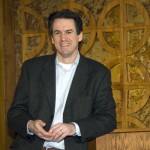
In Matthew’s Gospel, the story of Jesus walking on water morphs into a story of Peter walking on, then sinking into, the same water. It begins as a statement about Jesus’ authority; for Jesus’ contemporaries had learned from scripture that such mastery over the waters is God’s accomplishment. When Peter tells Jesus to call him, too, onto the lake, the story transitions into an illustration of what it looks like when people express faith in Jesus.
Whatever the origins of this story and however it might or might not relate to a predawn experience Jesus’ friends had on the volatile Sea of Galilee, the story prefers to press other questions. It serves up food for thought, mostly about who Jesus was and how he was remembered, but also about the nature of faith. Over the centuries this passage has fed Christians’ allegorical reflections on what it means to walk faithfully in fearful circumstances.
Peter’s Request
Those reflections have not always agreed on what the passage means. One big question: What should we make of Peter’s request to walk on the sea, and then his fearful response to the fierce storm?
Some people think Peter should keep his piehole shut. They accuse him of putting Jesus to the test, of demanding Jesus prove who he is, instead of rightly keeping quiet, reverent, and safe in the boat. Peter, this reasoning continues, had no chance against the wind and the whitecaps. Faith means staying in the boat, trusting Jesus to keep you secure there.
Others disagree. They say the story implicitly commends Peter’s desire to walk where his “Lord” walks, even though he doesn’t manage to stroll all the way to shore alongside Jesus. I think this interpretation makes better sense of the story. The other option makes it needlessly cruel for Jesus to agree to summon Peter and fails to account for why Peter initially progresses further from the boat than I certainly could.
Faith among the Disarray
The most important detail to consider is the place Peter asks to go. He and his companions apparently have spent nearly the whole night struggling to get across the blasted lake before Jesus shows up near daybreak. It’s not a massive body of water, never more than seven miles across when traveling east-west. Yet they’ve not been able to traverse it, for the storm has “battered” or “thrashed” their boat. As for the churning sea, in their worldview it represents chaos and danger. Then they think they see a ghost.
It’s terror all around.
Fear erupts because they anticipate how the story will probably end. All night they have been threatened by the prospects of established boundaries being overrun. Water leaping up from its environs to pull down an entire boat. A ghost intruding into the realm of the living perhaps to claim new victims. Disciples left to die at the mercy of more powerful forces.
Then they realize: it’s Jesus, striding over the watery chaos.
So, why would Peter want to go out there? After all, Jesus himself is not exactly respecting the natural boundaries everyone is used to. There’s something scary about that, too.
I doubt Peter expects a walk on the sea will alleviate all his fears. Rather, his desire to join Jesus on the water expresses a desire for transcendence. He’s not trying to be Jesus, he’s trying to be with him. Peter wants to share Jesus’ unbounded place, to put himself beyond the forces and expectations that determine our usual existence, whether for better or for worse.
The final scene in The Truman Show illustrates this impulse nicely, when Truman leaves his boat and walks across the ledge at the horizon of the (spoiler alert!) fake sea. Each step brings him closer to breaking out of an artificial, imposed existence. But here’s a key difference: Truman’s walk to fullness is made easier, or perhaps made to tempt him to stay within his fabricated but familiar world, because the show’s producer has turned off the stormy weather. That sea is flat.
When Peter steps out of his boat, he enters a tumult. His motive isn’t to escape from threat, for he goes into a situation where the threats will now look different, into a place where Jesus is defying and reordering the assumed boundaries.
Isn’t this what history’s most faithful people have demonstrated? Not all of them were great believers, but they knew that if God might be encountered anywhere, God will be found in places where the regular delineations and predictable endings don’t apply as before. Sometimes incredibly turbulent places are also “thin places,” where God breaks through.
These heroes of faith find and illuminate God in settings where “the way things are” are reconfigured: where the poor receive support, the sick find comfort, and the oppressed enjoy dignity and freedom.
Watch the Video: Faith Leaders on the Debt Ceiling Debate
Prompted by the Congressional debate over the debt ceiling, faith leaders from nearly every tradition have banded together to fight potential cuts to social programs they see as crucial to supporting the nation’s vulnerable and poor. A handful were even arrested at the U.S. Capitol on Thursday, as they protested the fact that government spending reductions will further strain resources for houses of worship. “We need to reduce the federal deficit, but it is not necessary to make life yet tougher for moms who are trying to put food on the table for their kids…it’s not right, after all that poor people have been through, especially over the last few years, to hit them while they are down,” says David Beckmann, president of Bread for the World.
Faith in the World
The recently concluded politicking over the nation’s budget allows politicians to declare victory to certain constituents. It promises an uneasy détente, at least until the joint Congressional committee starts hunting specific targets for deficit reduction. It is also very likely to exacerbate the shameful and widening gap of wealth disparity in American society.
Whatever your thoughts on the budget’s likely effects, many will agree that the national budgeting process has (again) left some of our society’s most pressing needs mostly unaddressed: job creation, expanding services needed by the poor, and fair and compassionate health care. How will this familiar story end?
The events in Washington placed a burden on communities of faith. Rather, the events emphasized the urgency of those communities’ regular calling to side with the needy. Churches cannot just watch compassionately or lick the wounds inflicted by the social chaos fueled by poverty, unemployment, and illness. Many communities of faith, especially those already ravaged by these cruel forces, already actively seek local solutions through their own programs or in partnerships. In the wake of the budget “solution” and the frustration it produced, it’s clear that additional congregations must begin or increase similar efforts.
The view from the boat says churches aren’t equipped to make a difference in these areas. Just trying will prove frustrating, expensive, divisive, or only a drop in the bucket. Compassion? Sure, we can do that. But devoting resources toward real economic empowerment, and generously supporting programs with that same mission? Risky. Unpredictable.
Yes, Christians’ voices in political advocacy help and should also be amplified. But, now more than ever, churches that have never done so need to devote talents and money to begin the harder work of imagining new ways forward, new conceptions of what’s possible. Part of religious devotion is participating in bringing such rearrangements into existence, through service and cooperation.
The Nature of Faith
It is the nature of faith—humble, active faith—to be willing to throw oneself into a disorderly world and expect to encounter Jesus there. It is the nature of faith, even “little faith,” to want to transcend the normal “rules” and see what possibilities might be brought into being. It is the nature of faith to wonder what other supposedly unalterable outcomes Jesus might want us to take part in messing with. It is the nature of faith even to waver from time to time, when it has stepped into stressful, unfamiliar terrain.
Because, as Peter discovered, Jesus is there where the boundaries are being redrawn, extending life-giving stability when the chaos gets the upper hand.
Learn more about the ON Scripture Editorial Board Click here
Learn more about ON Scripture Click here
Like ON Scripture Click here
Follow ON Scripture Click here
ON Scripture is made possible by a generous grant from the Lilly Endowment

